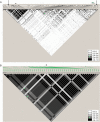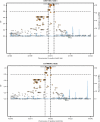The novel atherosclerosis locus at 10q11 regulates plasma CXCL12 levels
- PMID: 21415067
- PMCID: PMC3076669
- DOI: 10.1093/eurheartj/ehr091
The novel atherosclerosis locus at 10q11 regulates plasma CXCL12 levels
Abstract
Aims: Two single-nucleotide polymorphisms (SNPs), rs1746048 and rs501120, from genome wide association studies of coronary artery disease (CAD) map to chromosome 10q11 ∼80 kb downstream of chemokine CXCL12. Therefore, we examined the relationship between these two SNPs and plasma CXCL12 levels.
Methods and results: We tested the association of two SNPs with plasma CXCL12 levels in a two-stage study (n= 2939): first in PennCath (n= 1182), a Caucasian, angiographic CAD case-control study, and second in PennCAC (n= 1757), a community-based study of CAD risk factors. Plasma CXCL12 levels increased with age and did not vary by gender. There was no linkage disequilibrium between these two SNPs and SNPs within CXCL12 gene. However, CAD risk alleles at rs1746048 (C allele, P= 0.034; CC 2.33 ± 0.49, CT 2.27 ± 0.46, and TT 2.21 ± 0.52 ng/mL) and rs501120 (T allele, P= 0.041; TT 2.34 ± 0.49, CT 2.28 ± 0.46, and CC 2.23 ± 0.53 ng/mL) were associated with higher plasma levels of CXCL12 in age and gender adjusted models. In Stage 2, we confirmed this association (rs501120, T allele, P= 0.007), and meta-analysis strengthened this finding (n= 2939, P= 6.0 × 10(-4)). Finally, in exploratory analysis, the rs1746048 risk allele tended to have higher transcript levels of CXCL12 in human natural killer cells and the liver.
Conclusion: Coronary artery disease risk alleles downstream of CXCL12 are associated with plasma protein levels of CXCL12 and appear to be related to CXCL12 transcript levels in two human cell lines. This implicates CXCL12 as potentially causal and supports CXCL12 as a potential therapeutic target for CAD.
Figures


Similar articles
-
Genetic variants on chromosome 10q11.21 are associated with ischemic stroke in the northern Chinese Han population.J Mol Neurosci. 2013 Oct;51(2):394-400. doi: 10.1007/s12031-013-0025-5. Epub 2013 May 12. J Mol Neurosci. 2013. PMID: 23666823
-
GWAS implicated risk variants in different genes contribute additively to increase the risk of coronary artery disease (CAD) in the Pakistani subjects.Lipids Health Dis. 2018 Apr 19;17(1):89. doi: 10.1186/s12944-018-0736-2. Lipids Health Dis. 2018. PMID: 29673405 Free PMC article.
-
Effect of Coronary Artery Disease risk SNPs on serum cytokine levels and cytokine imbalance in Premature Coronary Artery Disease.Cytokine. 2019 Oct;122:154060. doi: 10.1016/j.cyto.2017.05.013. Epub 2017 Jul 10. Cytokine. 2019. PMID: 28705542
-
Blood CSF1 and CXCL12 as Causal Mediators of Coronary Artery Disease.J Am Coll Cardiol. 2018 Jul 17;72(3):300-310. doi: 10.1016/j.jacc.2018.04.067. Epub 2018 Jul 9. J Am Coll Cardiol. 2018. PMID: 30012324
-
CXCL12: a new player in coronary disease identified through human genetics.Trends Cardiovasc Med. 2010 Aug;20(6):204-9. doi: 10.1016/j.tcm.2011.08.002. Trends Cardiovasc Med. 2010. PMID: 22137643 Free PMC article. Review.
Cited by
-
Common Polymorphisms Linked to Obesity and Cardiovascular Disease in Europeans and Asians are Associated with Type 2 Diabetes in Mexican Mestizos.Medicina (Kaunas). 2019 Feb 5;55(2):40. doi: 10.3390/medicina55020040. Medicina (Kaunas). 2019. PMID: 30764545 Free PMC article.
-
Serum Fractalkine (CX3CL1) and Cardiovascular Outcomes and Diabetes: Findings From the Chronic Renal Insufficiency Cohort (CRIC) Study.Am J Kidney Dis. 2015 Aug;66(2):266-73. doi: 10.1053/j.ajkd.2015.01.021. Epub 2015 Mar 17. Am J Kidney Dis. 2015. PMID: 25795074 Free PMC article.
-
RNAi-based functional profiling of loci from blood lipid genome-wide association studies identifies genes with cholesterol-regulatory function.PLoS Genet. 2013;9(2):e1003338. doi: 10.1371/journal.pgen.1003338. Epub 2013 Feb 28. PLoS Genet. 2013. PMID: 23468663 Free PMC article.
-
CXCL12 Derived From Endothelial Cells Promotes Atherosclerosis to Drive Coronary Artery Disease.Circulation. 2019 Mar 5;139(10):1338-1340. doi: 10.1161/CIRCULATIONAHA.118.037953. Circulation. 2019. PMID: 30865486 Free PMC article. No abstract available.
-
Targeting immune cell recruitment in atherosclerosis.Nat Rev Cardiol. 2024 Nov;21(11):824-840. doi: 10.1038/s41569-024-01023-z. Epub 2024 Apr 25. Nat Rev Cardiol. 2024. PMID: 38664575 Review.
References
-
- Samani NJ, Erdmann J, Hall AS, Hengstenberg C, Mangino M, Mayer B, Dixon RJ, Meitinger T, Braund P, Wichmann HE, Barrett JH, Konig IR, Stevens SE, Szymczak S, Tregouet DA, Iles MM, Pahlke F, Pollard H, Lieb W, Cambien F, Fischer M, Ouwehand W, Blankenberg S, Balmforth AJ, Baessler A, Ball SG, Strom TM, Braenne I, Gieger C, Deloukas P, Tobin MD, Ziegler A, Thompson JR, Schunkert H. Genomewide association analysis of coronary artery disease. N Engl J Med. 2007;357:443–453. - PMC - PubMed
-
- Kathiresan S, Voight BF, Purcell S, Musunuru K, Ardissino D, Mannucci PM, Anand S, Engert JC, Samani NJ, Schunkert H, Erdmann J, Reilly MP, Rader DJ, Morgan T, Spertus JA, Stoll M, Girelli D, McKeown PP, Patterson CC, Siscovick DS, O'Donnell CJ, Elosua R, Peltonen L, Salomaa V, Schwartz SM, Melander O, Altshuler D, Merlini PA, Berzuini C, Bernardinelli L, Peyvandi F, Tubaro M, Celli P, Ferrario M, Fetiveau R, Marziliano N, Casari G, Galli M, Ribichini F, Rossi M, Bernardi F, Zonzin P, Piazza A, Yee J, Friedlander Y, Marrugat J, Lucas G, Subirana I, Sala J, Ramos R, Meigs JB, Williams G, Nathan DM, MacRae CA, Havulinna AS, Berglund G, Hirschhorn JN, Asselta R, Duga S, Spreafico M, Daly MJ, Nemesh J, Korn JM, McCarroll SA, Surti A, Guiducci C, Gianniny L, Mirel D, Parkin M, Burtt N, Gabriel SB, Thompson JR, Braund PS, Wright BJ, Balmforth AJ, Ball SG, Hall AS, Linsel-Nitschke P, Lieb W, Ziegler A, Konig I, Hengstenberg C, Fischer M, Stark K, Grosshennig A, Preuss M, Wichmann HE, Schreiber S, Ouwehand W, Deloukas P, Scholz M, Cambien F, Li M, Chen Z, Wilensky R, Matthai W, Qasim A, Hakonarson HH, Devaney J, Burnett MS, Pichard AD, Kent KM, Satler L, Lindsay JM, Waksman R, Epstein SE, Scheffold T, Berger K, Huge A, Martinelli N, Olivieri O, Corrocher R, McKeown P, Erdmann E, Konig IR, Holm H, Thorleifsson G, Thorsteinsdottir U, Stefansson K, Do R, Xie C, Siscovick D. Genome-wide association of early-onset myocardial infarction with single nucleotide polymorphisms and copy number variants. Nat Genet. 2009;41:334–341. - PMC - PubMed
-
- Abi-Younes S, Sauty A, Mach F, Sukhova GK, Libby P, Luster AD. The stromal cell-derived factor-1 chemokine is a potent platelet agonist highly expressed in atherosclerotic plaques. Circ Res. 2000;86:131–138. - PubMed
-
- Zeiffer U, Schober A, Lietz M, Liehn EA, Erl W, Emans N, Yan ZQ, Weber C. Neointimal smooth muscle cells display a proinflammatory phenotype resulting in increased leukocyte recruitment mediated by P-selectin and chemokines. Circ Res. 2004;94:776–784. - PubMed
Publication types
MeSH terms
Substances
Grants and funding
LinkOut - more resources
Full Text Sources
Medical
Miscellaneous

